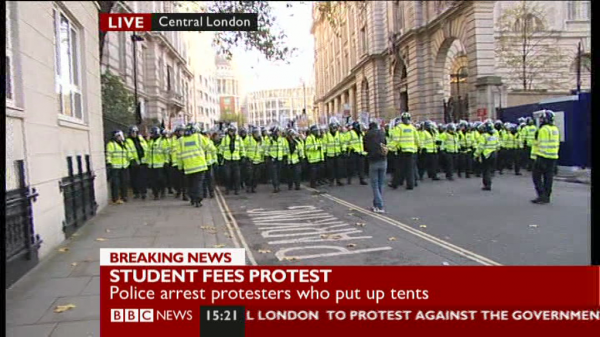Silencing protest
- November 9th, 2011
- Posted in Politics
- By Latentexistence
- Write comment
The right to peaceful protest is a vital part of democracy, and it has a long, distinguished history in the UK.
• Right to Peaceful Assembly – Article 11
• Right to Freedom of Expression - Article 10
• Right to freedom of thought, conscience and religion – Article 9
• Right to respect for private and family life – Article 8
(List taken from The Liberty Guide To Human Rights.)
In protests in London today (09/11/2011) the police controlled the march in a number of ways.
- Prohibited protesters from leaving the route of the march.
- Prohibited protesters from entering certain streets.
- Prohibited protesters from assembling for more than two hours at the end of the march.
- Stopped and search coaches on their way to the protest, delaying some beyond the start.
- Overwhelming numbers of police who were intimidating to protesters.
- Surrounded the march on all sides, making it impossible to see the protesters.
- Forcibly removed protesters and their tents from Trafalgar Square.
- Stopped and searched people at random.
- Demanded that people remove face coverings. (Why? So they can build a database of protesters?)
- Snatched certain people out of the crowd and removed them from the protest.
- Had undercover police in the crowd.
- Held protesters in place for some time at the end with no information on why or how to leave.
- Frequently blocked the protester’s way and held them up.
- Intimidation of would-be protesters with talk of baton rounds and warning letters as I wrote about in my last blog post.
The first three items on this list are courtesy of section 12 of the Public Order Act 1986. The more I find out about this legislation, the more I realise how draconian and evil it is. It does not seem to add anything worth having to existing laws, instead giving the police the ability to control and bully people. Section 12 allows police to tell people where they can and can’t go, and how long they can be there. Section 14 actually allows the police to order people to stay in one place, to restrict the numbers that can protest, and tell them to go home. Section 60 allows the police to stop and search whoever they like, without reason. Section 60AA allows them to order people to remove any clothing that might conceal their identity. This includes scarves, even if it is freezing cold. And for what purpose? The police would get a persons identity if they arrested them for a crime so the only reason to reveal it can be to gather details of who is protesting. Again, treating protest as a crime.
I will give some credit to the police; there was, as far as I know, no prolonged containment and no batons used. The march seemed (from my perspective via TV and Twitter) to be largely peaceful. This may in part be to the sheer numbers of police on the streets though. I know that some people would criticise the police if they did not have so many officers out but I believe this quantity of police to be overwhelming and intimidating. I have said before and will say again that if the police simply left people alone then that would remove the cause of most of the violence at previous protests. Yes, there might have been some vandalism, however police should target vandals if and when they do something wrong.
Medieval Jewish philosopher Maimonides said ”It is better and more satisfactory to acquit a thousand guilty persons than to put a single innocent one to death.” If this is applied to protest, it is better to let a hundred vandals go free than to stamp on the right to protest of ten thousand. Police should leave protesters alone and stop trying to control them.
Further reading
Police leaflet given out to protesters (PDF)
Police notice under Section 12(3) Public Order Act 1986 (PDF)
BBC: Thousands march in student protest over university fees
Channel 4 news: Police out in force for student protests
Comment policy: Please comment here rather than on Facebook or Twitter so that everyone can take part in the discussion. Please keep comments polite and refrain from personal insults. Please do not use anyone's name unless they have already revealed it in this forum. Due to the wide and varied audience of this blog, please do not give away personal information about the author unless he has already revealed it himself!






